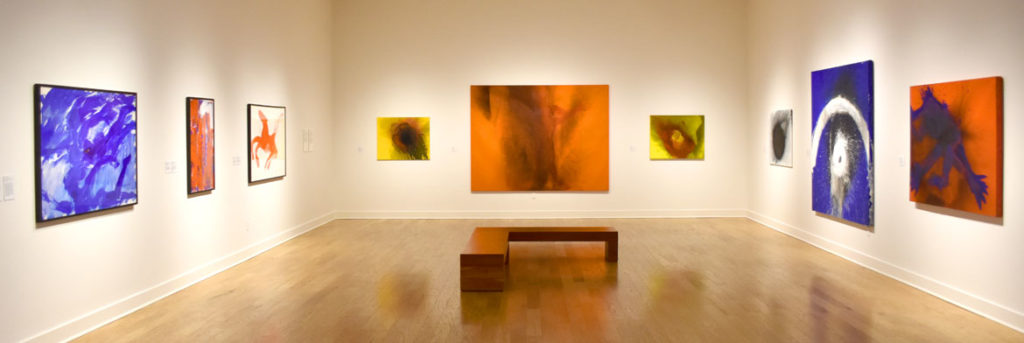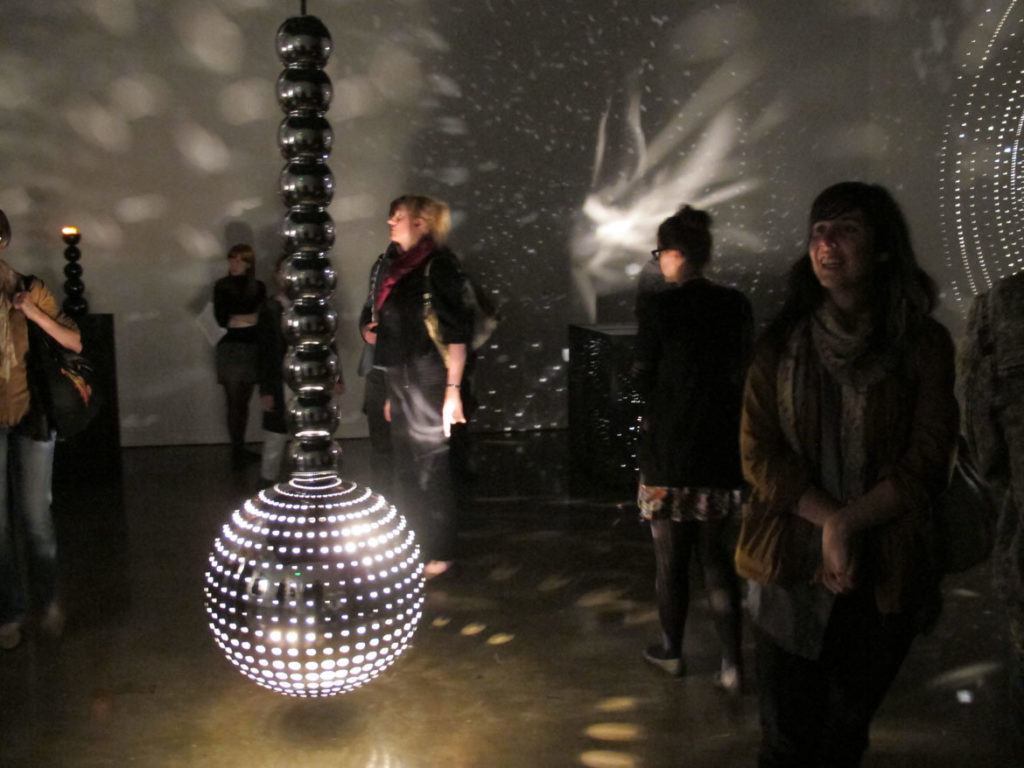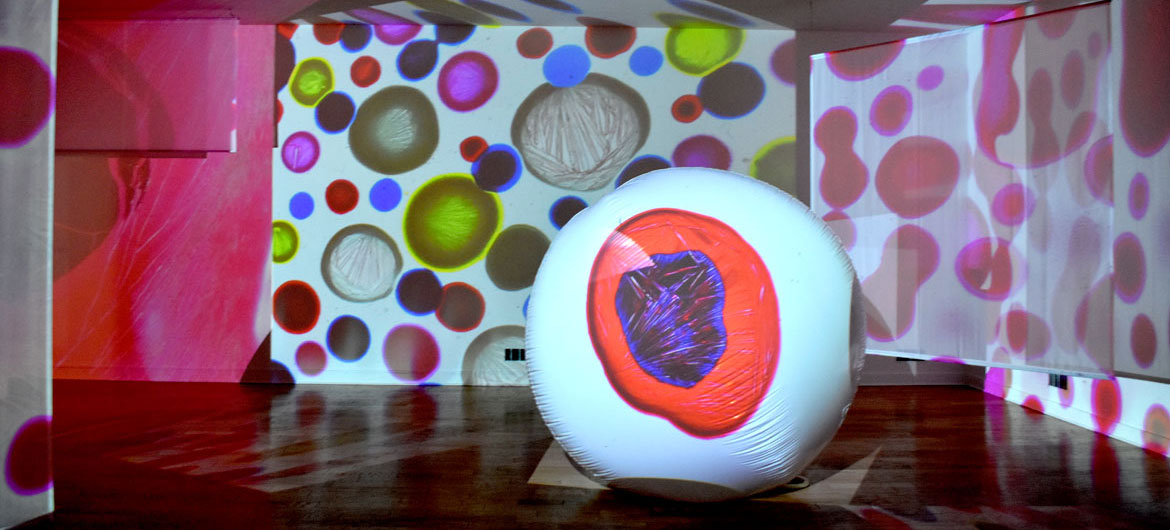The artist Otto Piene was 15 when his entire class at his school in Lübbecke, Germany, was drafted into the Wehrmacht. The conscription of kindsoldaten (“child soldiers”) into the military was a sign that the Second World War was going poorly for Hitler’s Germany after their defeat by Soviet forces at Stalingrad in early 1943, ending Germany’s long, murderous siege of the city. Piene’s father—a physics teacher and a rising headmaster of gymnasiums (roughly equivalent to middle and high schools) before the Nazis took over and his career stalled in this small northwestern town—accompanied the boys to the train that would take them away.
“In retrospect, I probably have never seen him more moved than when he delivered us off to the service,” Piene recalled in a 1988 oral history interview for the Smithsonian Archives of American Art. “…My father died of a heart attack six weeks later.”

Shaped by his wartime experiences, Piene (1928-2014) would come to make art with smoke and flame, with machines that produced cosmic light shows, with giant inflated balloons. He became a Cold War counterculture artist, a utopian “Whole Earth Catalog” DIY futurist. He employed technology and machines to create psychedelic art to spread peace.
“My endeavor is twofold: to demonstrate that light is a source of life which has to be constantly rediscovered, and to show expansion as a phenomenal event. Everything is striving for larger space,” Piene wrote for a New York exhibition in 1965. “We want to reach the sky. We want to exhibit in the sky, not in order to establish there a new art world, but rather to enter new space peacefully—that is, freely, playfully, and actively, not as slaves of war technology.”
“Fire and Light: Otto Piene in Groton, 1983–2014,” at the Fitchburg Art Museum from Feb. 9 to June 2, 2019, explores the artist’s late work, when he was director of Massachusetts Institute of Technology’s Center for Advanced Visual Studies in Cambridge. Settled in Groton, on a rural property northwest of Boston, he continued to expand upon projects and ideas he first explored in the 1950s and ‘60s.
The Fitchburg museum has scheduled a “Sky Art” event for on Sunday, June 2, from 2:30 to 4:30 p.m. at Lowe Park, on Elm Street across from the museum. (The event was rescheduled after poor weather earlier this year.) Curator Lisa Crossman will lead a closing discussion in the museum galleries 1:30 p.m. that day.
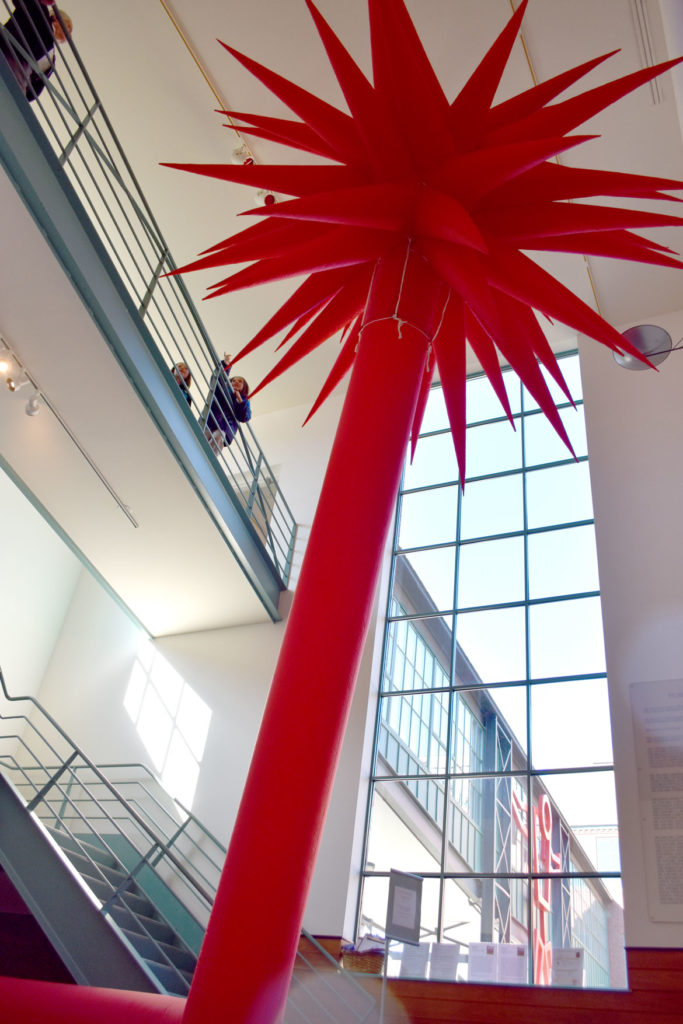
But before all that was Piene’s war. He served in antiaircraft units in Minden, just east of his hometown, and then a ways south, at an airbase at Gütersloh that was home to some of the first fighter jets. He became head gunner of a flak gun.
During downtimes, he drew and painted watercolors in his sketchbook of dogs, of surrounding farms, of a child’s eyes just peeking above the collar of a man-sized Wehrmacht coat, of the yellow and green four-barreled flak gun pointed up at a blue sky, of an open field and the moon glowing above in a blue-black night sky.
“All you have to do is stare at the sky. That’s what you do if you’re a flak soldier. You try to see the tiny points approaching, where they are, and try to identify them,” Piene told the Smithsonian interviewer in 1988. “…In those days, the clear sky and the most beautiful sky was the most dangerous sky, because it was well suited for large scale aerial attacks. What we did like was the crummiest weather, that was the safest, the rain, mist, low clouds, everything.”
They spent days fighting low-diving fighter planes. They spent nights battling under skies lit up by searchlights and tracer fire and explosions.
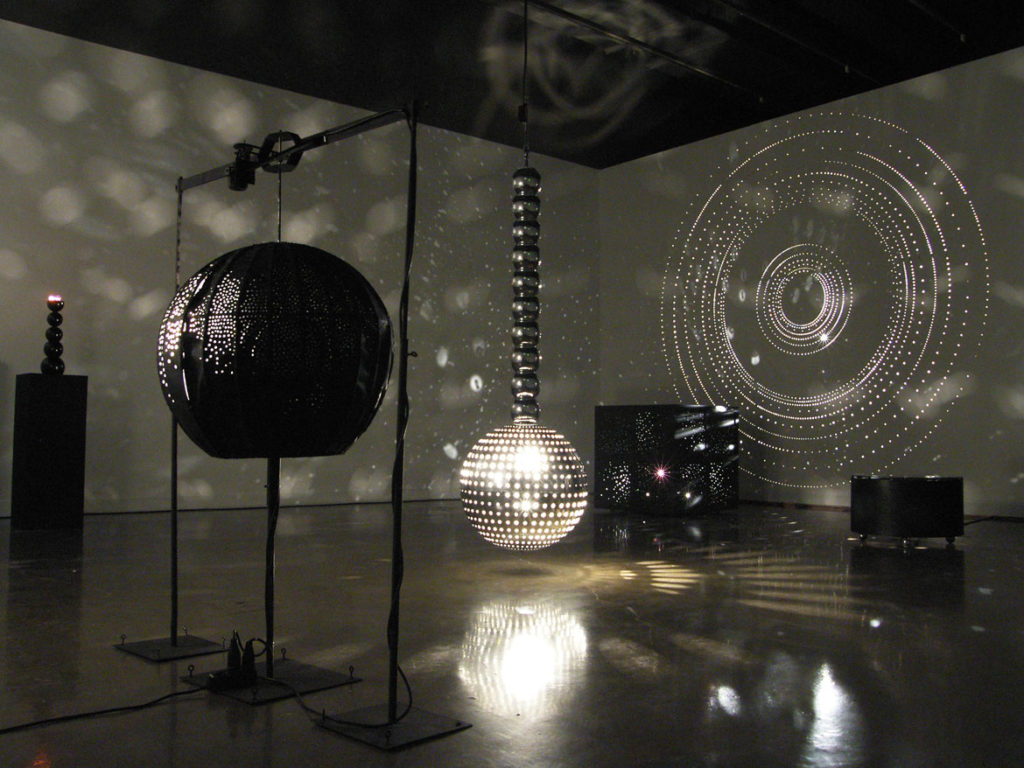
“As gunner at a four-barrel flak, surrounded by detonations, at night I used to see tracers draw their lines, hectically beautiful,” Piene wrote for his 1965 exhibition “Piene: Light Ballet” at New York’s Howard Wise Gallery. “But fear came before beauty; seeing was aiming.”
Piene turned 17 in April 1945, was reassigned to an adult Labor Corps Infantry in northern Germany, and was discharged a couple of days before the official capitulation in May 1945. “I had only two things left in my uniform jacket: a sketchbook made of sheets of war-mail paper and a watercolor set,” Piene recalled in 2011 (as quoted in the catalogue for the Harvard Art Museums’ 2018 exhibition “Inventur: Art in Germany, 1943-55”). He wandered toward home, with a detour to Gluckstadt at the mouth of the Elbe River.
“It was the smoothest, the largest, and the most incredibly glistening and reflecting waterplane mirror that you’ve ever seen. It’s entirely a huge expanse of glistening quicksilver under a flawless sky,” Piene told the Smithsonian interviewer in 1988. “I became very suddenly aware of how the war was over and how this was not a great threat, but this was just the greatest beauty that didn’t mean an invitation to death or disaster.”
If this is the kind of coverage of arts, cultures and activisms you appreciate, please support Wonderland by contributing to Wonderland on Patreon. And sign up for our free, weekly newsletter so that you don’t miss any of our reporting.
Countdown To Zero
Fall 1945: Piene’s mother traveled by freight train to a British internment camp for German soldiers. She arranged for her son’s release so he could return home in time for the start of school. “We thought at the end of the war, there was never going to be anything again: there wasn’t going to be industry, or any recovering, or any people who had enough to eat,” Piene recalled in the catalog for his 2011 exhibition “Lichtballet” at MIT’s List Visual Arts Center. “So there was a general sense of doom during the first years after World War II, and everything was in shambles and everything was destruction and everything was in incredible decay and ruin.”
Piene went on to study art and philosophy in college in Munich, Dusseldorf and Cologne. In 1953, he helped with graphic design for the “Alle sollen besser Leben (Everybody Is to Live a Better Life)” exhibition in Dusseldorf “about the economic reconstruction and the rebirth of industry and science and education,” Piene told the MIT interviewer in 2011.
The German economy was recovering under a fairly stable, conservative postwar government that “represented a Germany that was not what we were dreaming of,” Piene said in a March 2014 interview for the Institute of Contemporary Art at the University of Pennsylvania in Philadelphia. Bored by post-war Dusseldorf, offended by “the passivity of the people,” and resisting what he saw as Germany’s growing materialism, in 1957, Piene and a school friend, artist Heinz Mack, formed what they would come to call Group Zero.
“From the beginning we looked upon the term not as an expression of nihilism—or a Dada-like gag,” Piene wrote in The Times Literary Supplement of London in 1964, “but as a word indicating a zone of silence and of pure possibilities for a new beginning as at the count-down when rockets take off—zero is the incommensurable zone in which the old state turns into the new.”
Light Ballet
Group Zero presented one-night exhibitions in Piene’s studio and published magazines. The loose-knit collective would come to include Yves Klein Jean Tinguely, Arman, Lucio Fontana and Antoni Tapies.
Fascinated by energy, light and vibration, they pushed on from painting into kinetic sculpture, performance art, new media. At first, Mack made white-on-white paintings with paint applied in thick repeating lines. Then he moved on to constructing metal sculptures of rippling aluminum screens and glass and mirrors. “Your work should act like an instrument and the light will be the medium. And the instrument of my sculptures will play the music with the light,” Mack told New York’s Guggenheim Museum in 2014.
Gunter Uecker, another core member of the group, pounded nails into boards and painted them all white. The patterns the hundreds of nails made seemed to shift and ripple.
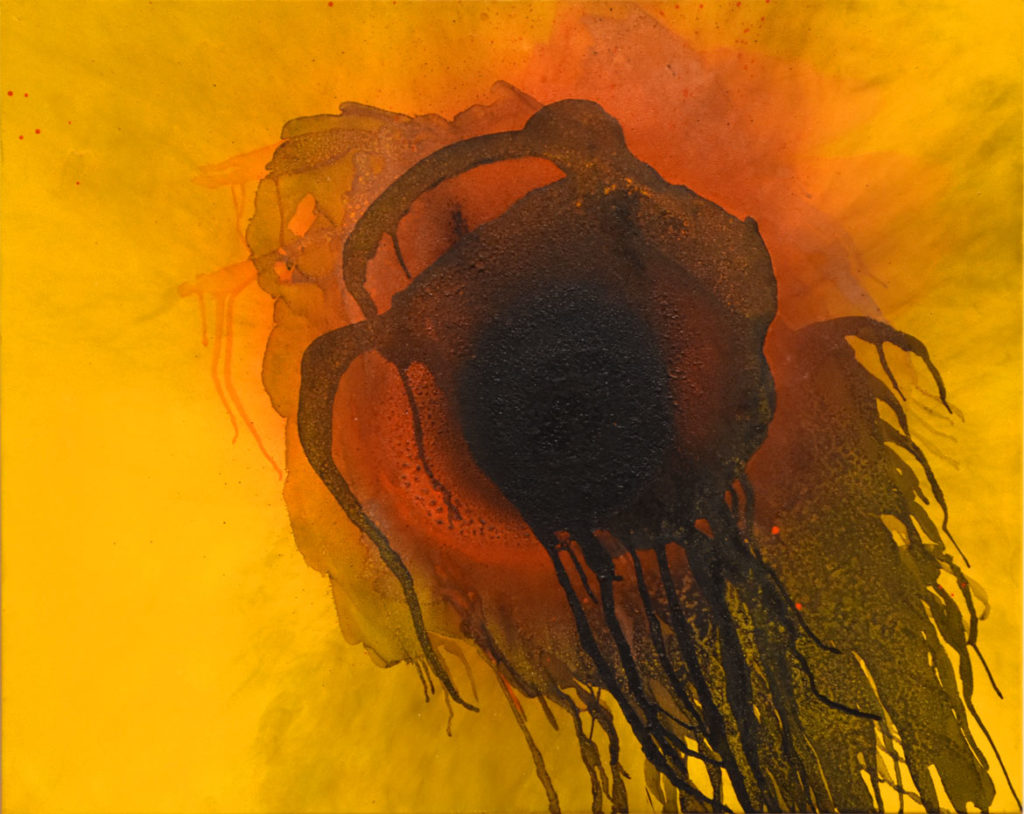
In the early 1950s, Piene had drawn acrobats holding each other above their heads or forming pinwheel formations. By the late ‘50s, he had moved to abstraction. Piene punched thousands of holes into cardboard sheets to create stencils that he used to create dot paintings. Then in artworks with titles like “‘First Attempt to Burn the Night,” Piene applied soot to the canvas through stencils. He created fire paintings by lighting solvent and fixative on canvases, tilting and turning the paintings as the fluids burned, creating a “choreography of fire on the canvas. … pictures grew within seconds on a border line between destruction and survival,” Piene wrote for his 1965 Howard Wise Gallery exhibition.
In 1959, Piene opened his first one-man exhibition at Dusseldorf’s Galerie Schmela by performing his new “Lichtballett (Light Ballet).” He stood in the darkened room, before windows covered by closed curtains, gazing upward as he shined a flashlight through the holes of the stencils he’d used for his paintings, throwing dotted arcs of light across everything. The “Light Ballets” turned the war’s tracer bullets into a peaceful dance of radiant stars and swirling galaxies.
“Light Ballet,” Piene told the Smithsonian interviewer in 1988, was “a means, as a vehicle, so to speak, to do something more poetic … in references to the universe or the sun and all that, the stars or light as a light force, and light as the force that rules the sky.”
Soon Piene was enlisting friends to help create more elaborate light performances. Then in 1960, Piene began building twinkling light machines. They were perforated boxes and globes as well as metal balls studded with dozens of light bulbs. They resembled Sputnik, air conditioners, robots, disco balls, the Death Star, but they radiated calm and wonder.
New York Times writer Grace Glueck called Piene’s November 1965 exhibition “Piene: Light Ballet” at Howard Wise Gallery “a high-voltage dazzler with a stellar cast of eight (2 perforated, polished aluminum spheres, 2 bulb-studded globes, 2 black brass columns, a pair of aluminum drums with motorized discs).”
In 2013, with artist and former teaching assistant John Powell, Piene began creating “Light Robots,” light sculptures that spun and moved, on view (but stationary) in “Fire and Light” at Fitchburg. “Only fully realized shortly before his death in 2014,” organizers of the Fitchburg exhibition write, “Piene never saw his robots perform outside the MIT project space where they were constructed.”
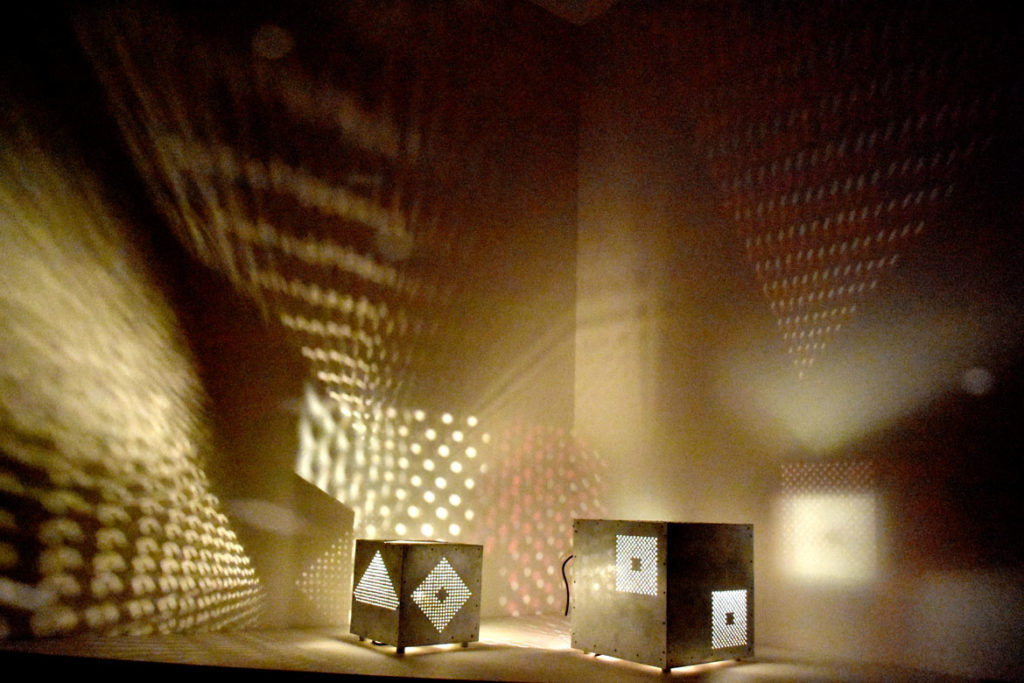
“Up to now we have left it to war to dream up a naïve light ballet for the night skies, we have left it up to war to light up the sky with colored signs and artificial and induced conflagrations,” Piene wrote in the “ZERO 3” publication from 1961. “Imprisoned mankind achieves wonders defending itself. When will our freedom be so great that we conquer the sky for the fun of it, glide through the universe, live the great play in light and space, without being driven by fear and mistrust? Why do we not pool all human intelligence with the same security that accompanies its efforts in time of war and explode all the atom bombs in the world for the pleasure of the thing, a great display of human inventiveness in praise of human freedom? As a spectator of this astronautic theater, man would not have to take cover, he would be without fear, free, not bound by purpose.”
Group Zero “wanted to provoke the museums and bring fun to the public. We did,” Mack told The New York Times in November 1964. “But now that we’ve found some success our friendship will probably end.” Mack unilaterally dissolved the collective in 1966. “The Zero spirit is still alive,” Mack told the newspaper that April. “But for me, no more collaboration. From now on, I take my own direction.”
Expanded Consciousness
The Kodak carousel slide projector provided inspiration for Piene’s next project. He had moved to Philadelphia in 1964 to teach at University of Pennsylvania. The newly available machine allowed him to automatically project dozens of slide images. At the school, he began hand-painting hundreds of slides with transparent paints and inks. He continued work on the project when he landed in New York the following year.
There Piene friendship’s expanded with video art pioneer Nam June Paik (they’d first met at one of Piene’s “Light Ballets” in Germany) and his frequent collaborator Charlotte Moorman. They were part of an international movement of artists using technology and engineering to create immersive, transcendental, psychedelic experiences.
“When we say expanded cinema we actually mean expanded consciousness. Expanded cinema does not mean computer films, video phosphors, atomic light, or spherical projections,” Gene Youngblood wrote, listing all the technical attributes, in his 1970 book “Expanded Cinema.” “Expanded cinema isn’t a movie at all: like life it’s a process of becoming, man’s ongoing historical drive to manifest his consciousness outside of his mind, in front of his eyes.”
Stan VanDerBeek went from making stop-motion animations satirizing Soviet Premiere Nikita Krushchev to trippy computer animation “Poemfields” and immersive projection and “expanded cinema” environments, like his “Movie-Drome“ (1963-1965), a spherical theater he built at built Stony Point, New York, in which people could lie down to watch to “newsreels of dreams.” In New York, artist Robert Rauschenberg and engineer Billy Kluver of Bell Telephone Laboratories launched “Experiments in Art and Technology (E.A.T.)” to foster collaborations between artists and engineers.
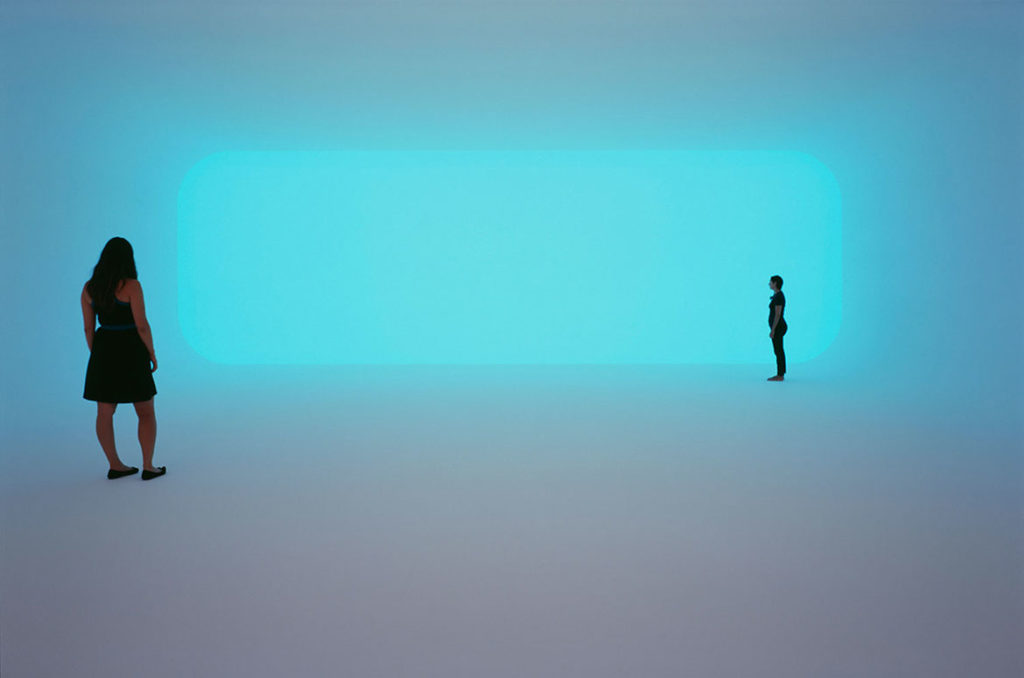
Beginning in the mid-1960s, James Turrell, Doug Wheeler, Robert Irwin and other artists affiliated with Los Angles’ Light and Space movement shifted from making objects to altering spaces to create immersive works that often feel like mirages, operating at the very edges of our senses of perception. The long-term exhibition “Into the Light” at Mass MoCA in North Adams includes Turell’s 1991 ganzfeld room “Perfectly Clear.” Walk in and you quickly feel afloat. Details and corners that might orient us have been eliminated, except for the entrance portal, so it feels as if you’re walking into … a fog of brilliant, shifting color.
Meanwhile, Light Sound Dimension (uh, LSD) and Brotherhood of Light in the San Francisco Bay Area and the Joshua Light Show in New York were pioneering psychedelic light shows to accompany rock concerts. And one night in 1966, at an estate at Millbrook, New York, psychedelic drug pioneer Timothy Leary and friends passed around a pipe of the psychedelic DMT, danced, and listened to recordings of Bob Dylan and the Beatles while watching movies of skydivers, waterfalls, kids jumping on trampolines—their own version of expanded cinema. In the middle of the night, sheriff’s deputies and local District Attorney G. Gordon Liddy (later one of Nixon’s Watergate burglars) raided the place, arresting Leary and guests after they found some marijuana (charges were later dropped).
In New York, Piene and Aldo Tambellini launched Black Gate around 1966 and ’67. At the performance art and “electromedia” space, Tambellini presented “Black Zero,” in which live cello and hundreds of hand-painted slides and films combined to create “a maelstrom of audio-visual elements from which slowly evolves a centering or zeroing in on a primal image, represented in ‘Black Zero’ by a giant black balloon that appears from nothing, expands, and finally explodes with a simultaneous crescendo of light and sound,” Gene Youngblood recounted in “Expanded Cinema.”
At Black Gate, Piene’s hand-painted slides and projectors became “The Proliferation of the Sun.” In the version at the Fitchburg Art Museum, projectors fill a large gallery with shifting polkadots and veils of yellow and magenta. An 8 ½-foot-tall inflated ball sits in the middle, seeming at times like eyeball or like Saturn with its swirling storms. Piene was preparing this 35-minute digital and video version—featuring Piene reading instructions and some 1,120 hand-painted slides projected onto three screens—for the Nue Nationalgalerie in Berlin, Germany, when he died in 2014.
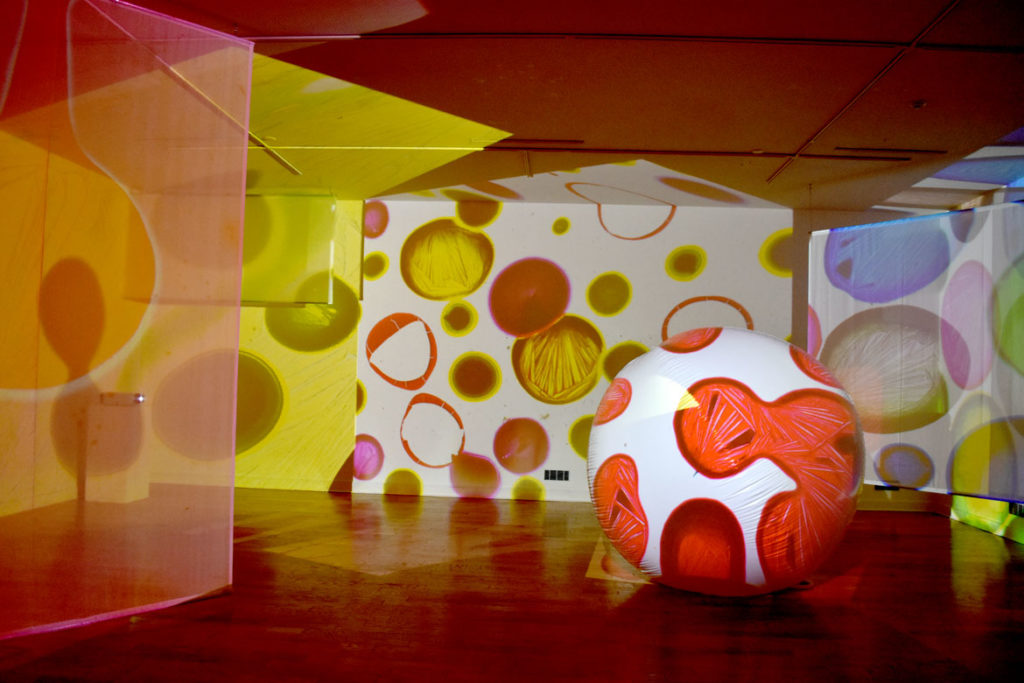
“’The Proliferation of the Sun’ was not just the slides or the imagery and sun imagery, but the performance as a whole. The performance involved sound and around 600 different tempi, along with various alternating projectionists,” Piene recalled in a 2010 interview included in the catalog for the 2010 Tate Liverpool retrospective of his friend Nam June Paik. “Everything in rhythm, following the sound, which was the guiding acoustic element … It was the music to the ‘proliferation’—except that the music was not music but words intoned rhythmically.”
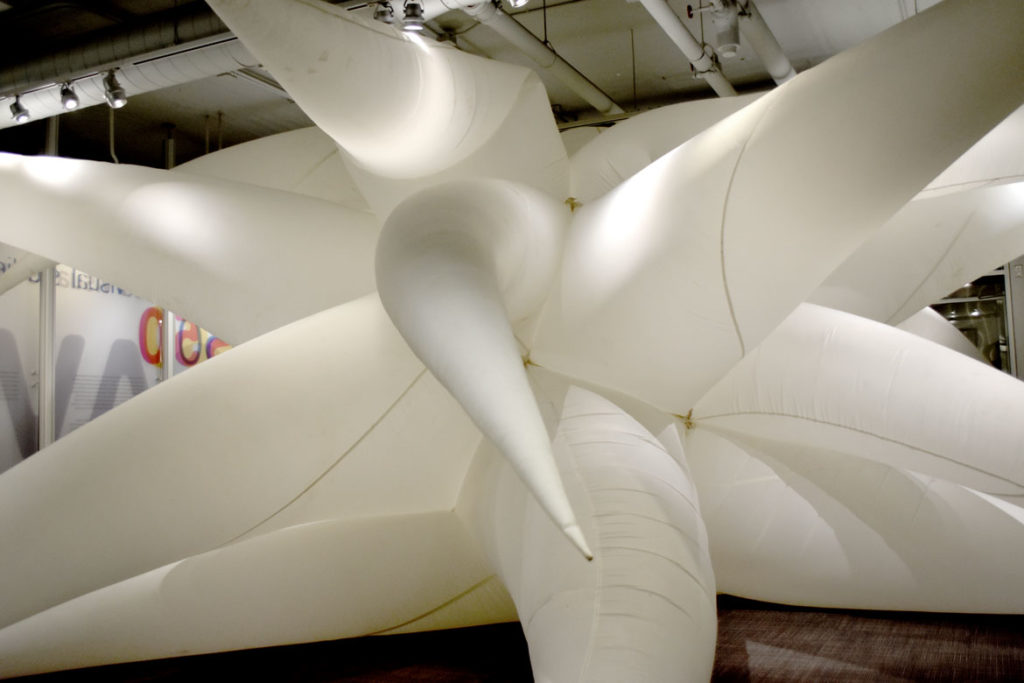
Sky Art
Piene’s 1965 Howard Wise exhibition led to an invitation to speak at Harvard’s Carpenter Center and then an interview at the Massachusetts Institute of Technology office of György Kepes. Kepes was a Hungarian-born artist who’d connected with Bauhaus circles in pre-war Europe and in 1937 became head of the Light and Color Department at the New Bauhaus that Lazlo Moholy-Nage formed Chicago. Kepes moved to MIT’s School of Architecture and Planning in 1945. “He told me about how he was planning a Center for Advanced Visual Studies,” Piene told the Smithsonian interviewer in 1988, “and would I want to be a fellow there.”
So in 1968, Piene moved to Cambridge to become the first fellow at Kepes’s center. Piene’s “Light Ballets” and “’The Proliferation of the Sun” had led him to begin making inflatable sculptures—“Sky Art,” he came to call them—that he began carrying into the heavens with helium balloons.
Piene showed his “Pneumatic Garden of Eden” at Buffalo’s Albright-Knox Art Gallery in 1968 and his “Octopus”—a black balloon with 10-foot-long tentacles—at New York’s Jewish Museum exhibition in 1969. For the first U.S. video art television program in January 1969, “The Medium is the Medium,” from the WGBH-TV studio in Boston, Piene used six tall balloons to float a 16-year-old girl in a crash helmet 25 feet above an Allston parking lot. (Watch Piene’s piece at minute 19:25. Tambellini and Nam June Paik were also featured in the program.) That June at MIT, he created a sort of fountain of balloon tubes and again flew the girl into the sky. Kepes told The Boston Globe that these were “explorations toward a new pageantry.”
In “Fire and Light” at the Fitchburg Art Museum, Piene’s 2014 inflatable sculpture “Red Star” rises about 30 feet high in the museum atrium. The red flower or mace-like form subtly inflates and deflates, seeming to breathe as the spines of the “star” gradually rise and fall. It recalls sculptures he showed over the years, including at the 1971 exhibition “Earth, Air, Fire, Water: Elements of Art” at Boston’s Museum of Fine Arts, at which Piene filled the rotunda with four 35-foot-tall flower-like inflated sculptures.
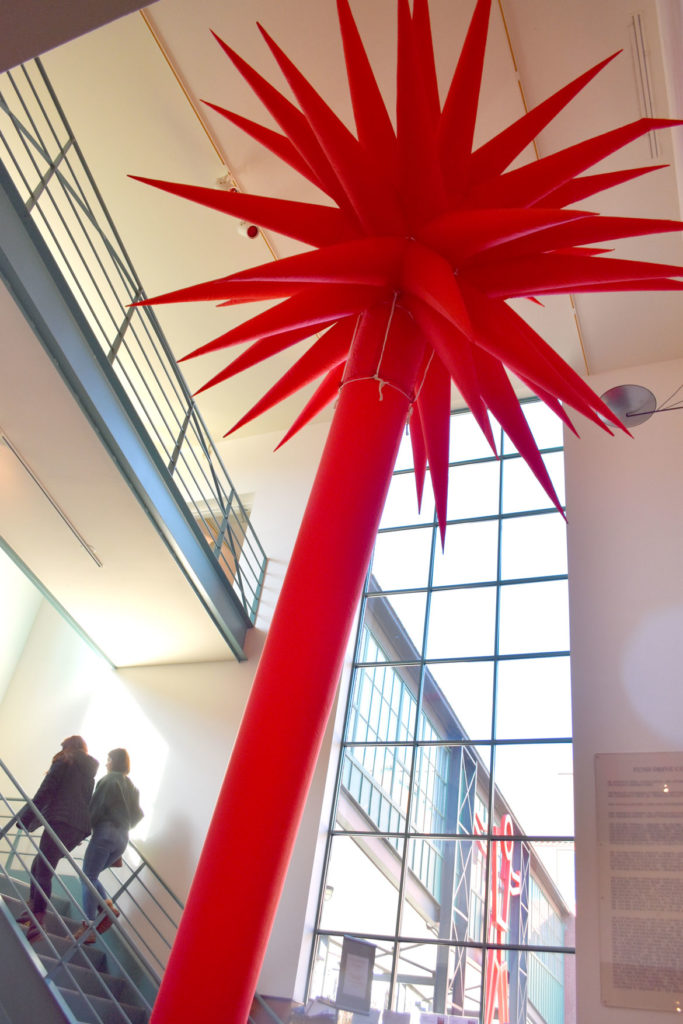
Meanwhile, Piene began working on a giant inflated rainbow—a “peace symbol”—that would span Boston’s Charles River. In March 1971, strong winds crashed the rainbow against a light post near the Harvard Bridge.
“The ripping of the materials by the winds, the natural forces at work, is part of the total experience. Sometimes the elements are supportive, and sometimes, like today, they are not,” Piene told the Globe. “The risk involved makes the project all the more interesting because the elements, the natural forces they represent, are never completely foreseeable. Sometimes you are strong, and sometimes they are strong.”
On a rainy, windy, cool morning that May, with help from volunteers and a couple tug boats, Piene got his rainbow to float three-quarters of the way across the Charles. The following year, Piene floated a 2,000-foot-long, helium-filled “Olympic Rainbow” over closing ceremonies of the 1972 Munich Olympics in Germany. The televised broadcast reached, perhaps, 500 million people around the world.
Piene’s engagement with art and politics was complicated. “Within the Group Zero, I was the only one who was thinking politically,” Piene recalled in a March 2014 interview for the ICA Philadelphia. “My friends said Otto should stay away from politics. Because they all thought after World War II, no more politics ever. Well, that’s not how it goes. Zero indeed took on, I shouldn’t say a political role, but a cultural role.”
But Piene was skeptical of activists. “Protest actions trend to become violent for one reason, because their messages are often presented in a visually or aurally ineffectual and unwitty way. … An effective pageantry of protest, a pageantry of constructive criticism, is needed. …. Beyond caricature and placards: the sky is the best canvas—a bulletin board for worded constructive compliant: sky writing, floating letters, vapor screens,” Piene wrote in his 1973 book “More Sky.” Later in the book, he said, “A carnival in the air … a theater in the sky …. Would also lend more convincing power to political theater, more convincing than bombs.”
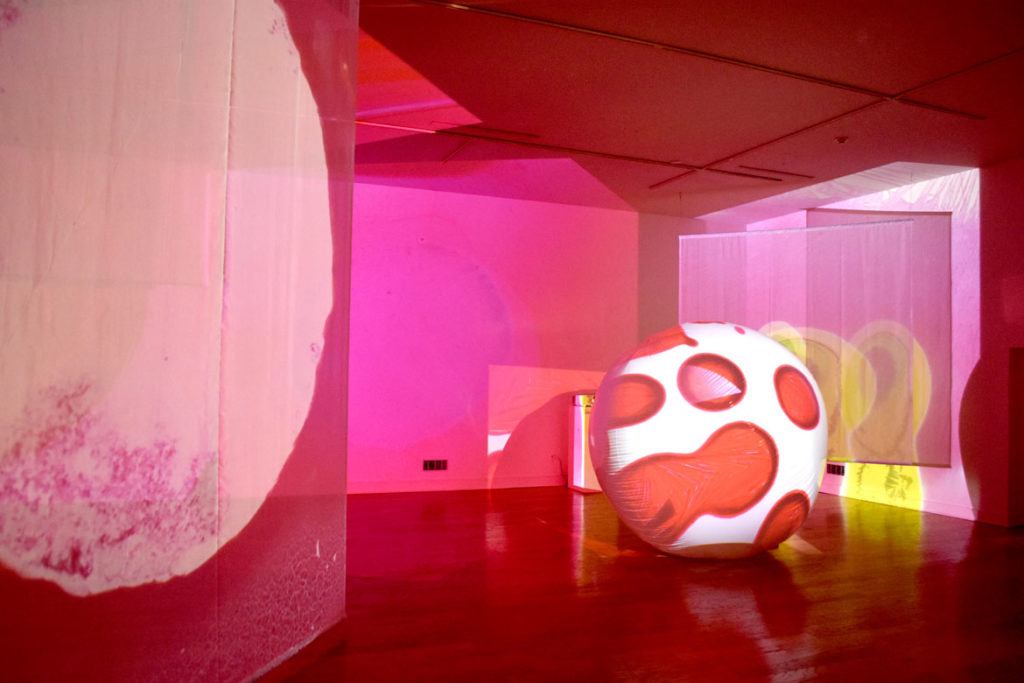
You Are The Center
Back in Cambridge, Piene had mixed feelings about his new base of operations. Early on, he told Kepes he was thinking of quitting MIT. “I think it was after one year, when I wanted to leave the Center [for Advanced Visual Studies] because I had so many other things to do in other places, and many of these things were projects, were somewhat tempting because one thing that everybody found out after having come to Boston is that it’s one thing to work here and one thing to find means and companionship to work, but making a living as an artist in Boston was very difficult,” Piene told the Smithsonian interviewer in 1988.
Kepes told him, “You can’t leave, you can’t go away, because you are the center.”
Piene went on to succeed Kepes, serving as the center’s director from 1974 until he retired in 1994. But in that role, Piene would grow deeply frustrated with working with MIT administrations and maintaining funding for the center.
Piene brought artists and scientists to MIT in September 1981 to “explore the expressive and cultural possibilities of sky and space” at the first “Sky Art Conference.” Presenters included Mack, Tambellini, Kepes, VanDerBeek, MIT stroboscopic photography pioneer Harold Edgerton, Christo, hologram artist Harriet Casdin-Silver, visionary painter Paul Laffoley, Antoni Muntadas, Paolo Soleri. “Sky Kiss,” a collaboration between Piene and Charlotte Moorman, featured the musician lifted into the sky by helium tubes as she played cello. The conference also featured a performance of Piene and Paul Earls’s “Icarus—A Sky Opera,” which they’d debuted in 1978.
“’Icarus’ is about the theme of Sky Art,” Piene told the Smithsonian interviewer in 1988. “…The Icarus story is some kind of a mascot, or some kind of poetic mascot story of Sky Art. Or if one wants to look at it somewhat more deeply, it’s a story about the human urge to fly, to elevate, or to um, to overcome gravity of bodily and mental kinds, so to speak. So, Icarus is just a wonderful story that embodies what’s on the mind of, what’s in the blood of many sky artists.”
Piene would organize additional Sky Art Conferences at Linz, Austria, in 1982, in Munich in 1983, and back at MIT in 1986.
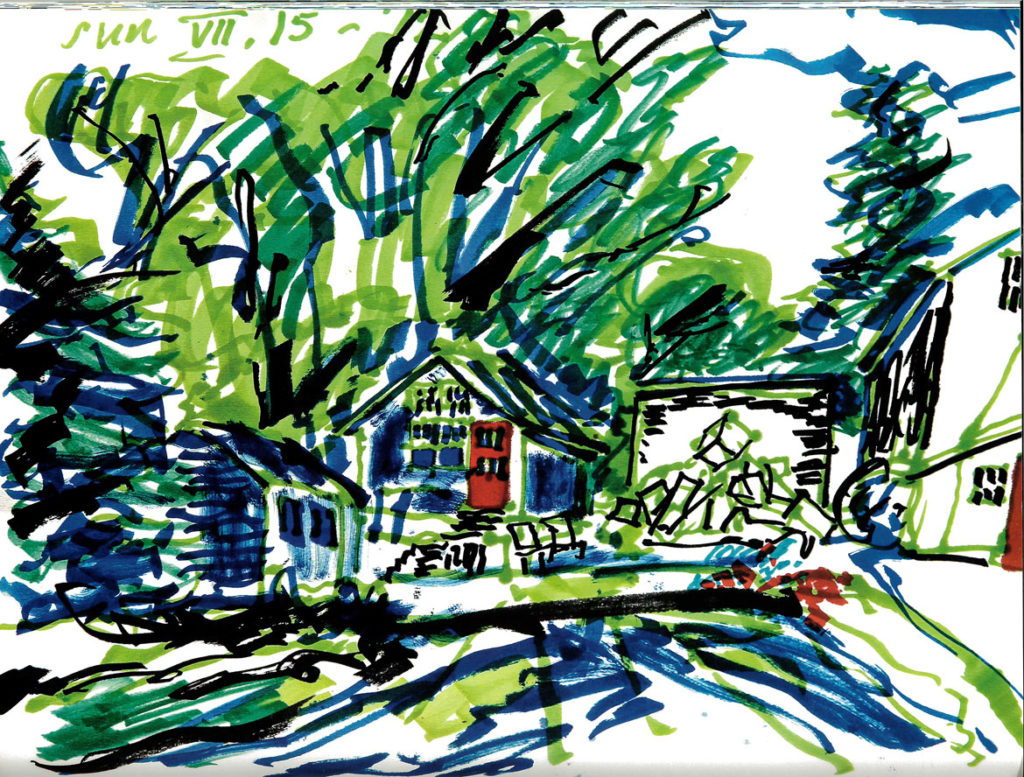
In between, in 1983, Piene moved to Groton, a small rural town northwest of Boston. “I’m now getting ready to set up a situation, meaning building some kind of a stone pit, in which I can do fire paintings again,” Piene told the Smithsonian interviewer in 1988, “but first I have to set up a stone pit for reasons of safety and obscurity.” The results, at times, resembled scorched rings or comets blazing across the sky.
Piene filled sketchbooks with images of old farm silos there and his flying stars. He lived to see an MIT exhibition of his “Light Ballet” machines and renewed museum embrace of Group Zero. He continued to develop his “Light Robots.” He refurbished “The Proliferation of the Sun” for an exhibition at the Nue Nationalgalerie in Berlin, Germany. He continued to launch “Sky Art” toward the clouds.
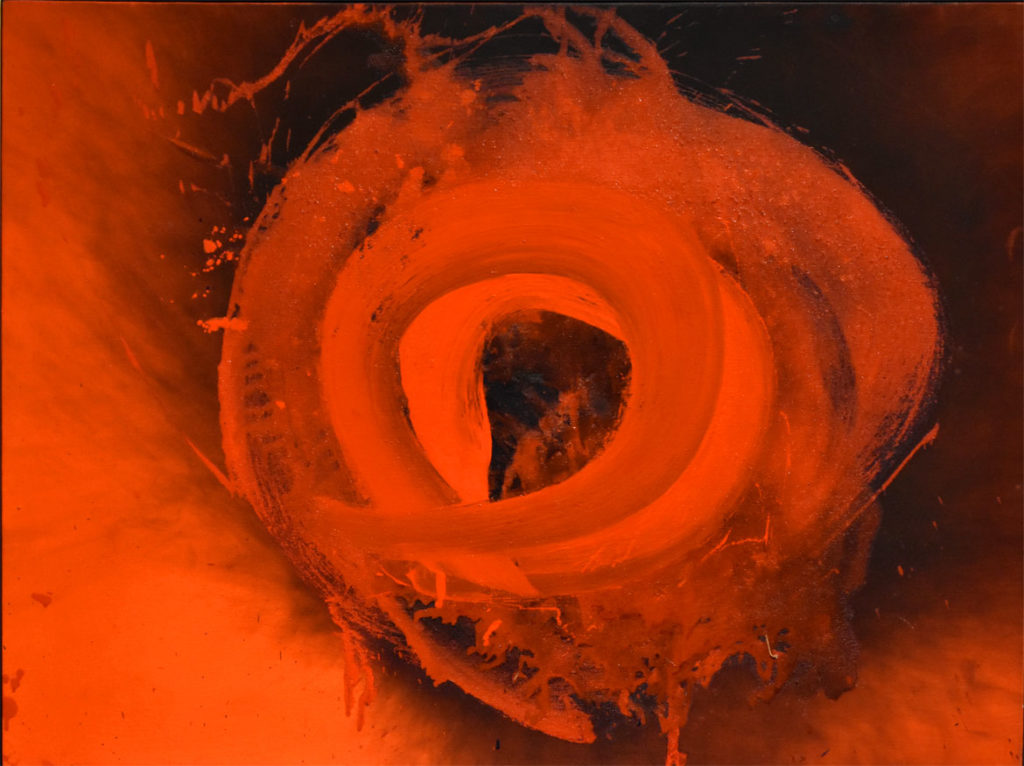
All throughout Piene maintained faith in the power of technology to improve the world. He spent much of his artistic career focused on rescuing technology from war and on overcoming the strong anti-technology feelings sparked by the Second World War’s explosion of murderous innovations.
“At MIT, we believed technology wasn’t only a war medium,” Piene told Art In America in 2010, “but could be used for healing, and to expand communication as a human means.”
“Technology is nothing without the imagery that fills it with power, that gives it human appeal,” Piene told The New York Times in 1978. “I see this linkage of art and technology as being in its initial stage. This is just the first century of it. I’m quite certain there will be more centuries to come.”
If this is the kind of coverage of arts, cultures and activisms you appreciate, please support Wonderland by contributing to Wonderland on Patreon. And sign up for our free, weekly newsletter so that you don’t miss any of our reporting.
